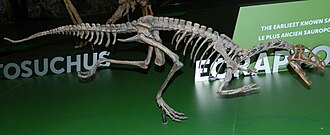Eoraptor
Eoraptor is one of the earliest known theropod dinosaurs. It was a very small omnivore or carnivore which lived in the Lower Triassic, about 231-228 million years ago (mya).[1][2] It is the only one of the possible early dinosaurs which can be exactly dated by a layer of volcanic ash close beneath the fossil.[2]
| Eoraptor | |
|---|---|

| |
| Reconstructed skeleton, Royal Ontario Museum | |
| Scientific classification | |
| Unrecognized taxon (fix): | Eoraptor |
| Species: | Template:Taxonomy/EoraptorE. lunensis
|
| Binomial name | |
| Eoraptor lunensis Sereno et al., 1993
| |
Eoraptor was a small, lightly-built archosaur that walked on two long legs. It was about 1 m (3.3 ft) it had light, hollow bones, a long head with dozens of small, sharp teeth, and five fingers on its grasping hands (two of the fingers on each hand were very small).
The fossil was found in the Ischigualasto Formation in the Argentine. This contains some of the oldest known dinosaur and archosaur remains. They are of top quality, number and importance. It is the only place in the world where nearly all of the Triassic is represented in an undisturbed sequence of strata. What is now badlands was then a volcanically active floodplain dominated by rivers, with a strongly seasonal rainfall.
Rhynchosaurs and cynodonts are by far the most common among the tetrapod fossils in the park. Dinosaurs make up only 6% of the findings,[3] but these include early samples of the two major lineages of dinosaurs (ornithischians and saurischians). The carnivorous Herrerasaurus is the most numerous of these dinosaur fossils.
Teeth
The teeth of Eoraptor are of two types. There are serrated, recurved teeth in the maxillae (upper jaws), like the teeth of theropods, and leaf-shaped teeth in the dentary (lower jaw), like the teeth of basal sauropodomorphs.[4]
Cladogram
Below is a cladogram based on the phylogenetic analysis conducted by Sues et al. in 2011, showing the relationships of Eoraptor:[5]
| Theropoda |
| ||||||||||||||||||||||||||||||||||||||||||||||||||||||||||||||||||||||||
A large analysis of early dinosaurs by Matthew Baron, David Norman and Paul Barrett (2017) found Eoraptor to be the earliest diverging member of Theropoda, within the larger clade Ornithoscelida.[6]
Eoraptor Media
Herrerasaurus (large), Eoraptor (small), and Plateosaurus (skull), three early saurischians
References
- ↑ Apaldetti C et al 2011. A new basal Sauropodomorph (Dinosauria: Saurischia) from Quebrada del Barro Formation (Marayes-El Carrizal Basin), Northwestern Argentina (2011). "A new basal sauropodomorph (Dinosauria: Saurischia) from Quebrada del Barro Formation (Marayes-El Carrizal Basin), northwestern Argentina". PLOS ONE. 6 (11): e26964. doi:10.1371/journal.pone.0026964. PMC 3212523. PMID 22096511.
- ↑ 2.0 2.1 Alcober Oscar A. & Martinez, Ricardo N. 2010. A new herrerasaurid (Dinosauria, Archosauria, Saurischia) from the Upper Triassic Ischigualasto Formation of northwestern Argentina (2010). "A new herrerasaurid (Dinosauria, Saurischia) from the Upper Triassic Ischigualasto Formation of northwestern Argentina". ZooKeys (63): 55–81. doi:10.3897/zookeys.63.550. PMC 3088398. PMID 21594020.
{{cite journal}}: CS1 maint: multiple names: authors list (link) [1] - ↑ Rogers R.R. et al 1993 while archosaurs make up 19% of the findings.The Ischigualasto tetrapod assemblage (late Triassic, Argentina) and 40Ar/39Ar dating of dinosaur origins. Science, 260, 794-797.
- ↑ Sereno P.C. et al 1993. Primitive dinosaur skeleton form Argentina and the early evolution of the Dinosauria. Nature 361, 64-66.
- ↑ Sues, Hans-Dieter et al 2011. A late-surviving basal theropod dinosaur from the latest Triassic of North America. Proceedings of the Royal Society B 278 (1723): 3459–3464
- ↑ Baron, M.G., Norman, D.B., and Barrett, P.M. (2017). A new hypothesis of dinosaur relationships and early dinosaur evolution. Nature, 543: 501–506.











